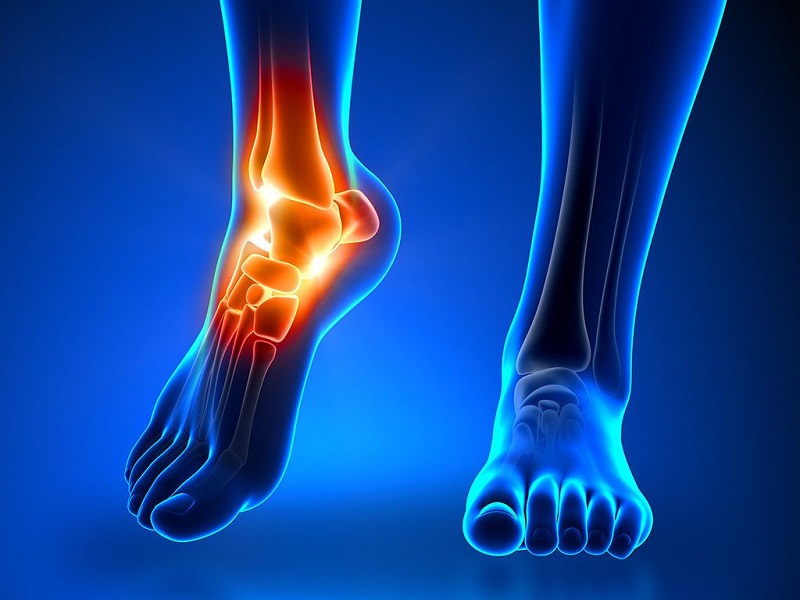
Knee Arthroscopy Services
 ACL Reconstruction
ACL Reconstruction
 ACL Tear
ACL Tear
 LCL Tear
LCL Tear
 PCL Reconstruction
PCL Reconstruction
 Meniscal Tears
Meniscal Tears
 Synovitis
Synovitis
 Patella Dislocation
Patella Dislocation

 ACL Reconstruction
ACL Reconstruction
 ACL Tear
ACL Tear
 LCL Tear
LCL Tear
 PCL Reconstruction
PCL Reconstruction
 Meniscal Tears
Meniscal Tears
 Synovitis
Synovitis
 Patella Dislocation
Patella Dislocation
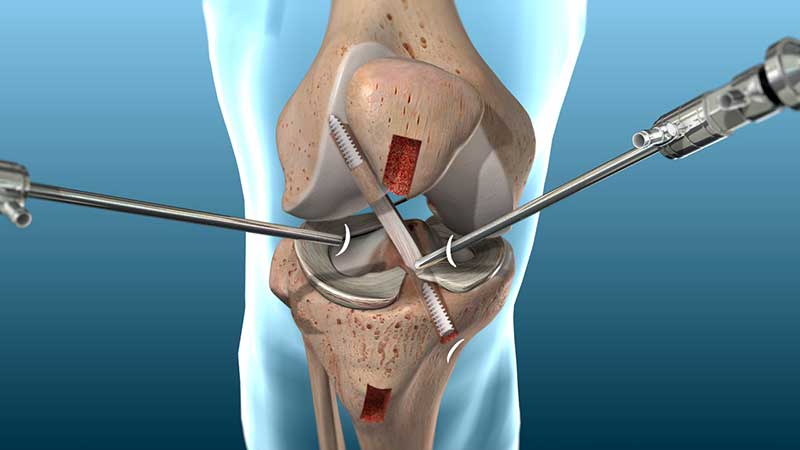
ACL reconstruction is a commonly performed surgery for individuals who engage in sports. The anterior cruciate ligament, located in the knee joint, is a band of tissue that connects the tibia to the femur, two of the main bones in the knee.
The knee joint is composed of the femur, patella, and tibia bones. The anterior cruciate ligament is the primary stabilizing ligament that connects the tibia to the femur. Put simply, the ACL is responsible for keeping the upper and lower leg bones in place and maintaining the overall stability of the knee joint.
When the ACL is healthy and intact, it provides crucial support to the knee, making it strong and stable. However, if the ACL is injured or damaged due to a sudden movement or accident, it can lead to difficulty placing weight or pressure on the knee, as well as problems with walking, playing sports, and sitting comfortably.
The anterior cruciate ligament (ACL) can be damaged when the knee joint is forced into an excessive bend or twist. The risk of injury is higher when both of these movements occur simultaneously.
ACL injuries are most commonly associated with sports participation. They typically occur when the foot is planted on the ground and an external force unexpectedly strikes the knee, causing it to twist or bend unnaturally. Such injuries can happen during activities that involve sudden changes in direction, rapid deceleration, or landing from a jump, such as in soccer, skiing, and other sports that require frequent stopping, starting, weaving, or jumping. ACL injuries can also result from falls, including those down stairs.
Due to the Sensing, Feeling or catching a pop or knock in the knee joint at the time of damage.
 Have swelling around the damaged knee within the first few time of the damage.
Have swelling around the damaged knee within the first few time of the damage.
 Having Pain or hurting on the knee and back of the knee.
Having Pain or hurting on the knee and back of the knee.
 Damaged restricted knee movement because of hurting inside or swelling.
Damaged restricted knee movement because of hurting inside or swelling.
After serious damage, you will seem to stop everything you are doing because of the hurting, but you may be capable to walk.
In cases where the anterior cruciate ligament (ACL) has been torn or ruptured and the knee is deemed unstable or compromised, an orthopedic surgeon may recommend an ACL reconstruction procedure.
 In the past sufferers played a lot of sports games and want to go back to playing sports.
In the past sufferers played a lot of sports games and want to go back to playing sports.
 To have another injury to your knee.
To have another injury to your knee.
Not all individuals with ACL damage require surgery to improve their condition. In some cases, physiotherapy treatments, exercises, and the use of a knee brace for added support may be recommended by an orthopedic doctor. This type of therapy may be suggested if:
 Your knee should be stable.
Your knee should be stable.
 You have a small part of torn in your ligament, rather than fully torn it.
You have a small part of torn in your ligament, rather than fully torn it.
 Your age is 65+ or above and don’t play a sports game.
Your age is 65+ or above and don’t play a sports game.
During an ACL reconstruction procedure, the damaged ligament is replaced by using new tissue, typically a tendon taken from the patient's knee. This surgery aims to restore stability and function to the knee joint, allowing for a full range of motion and improved support.
 ACL reconstruction normally needs 5-6 months to get a full improvement.
ACL reconstruction normally needs 5-6 months to get a full improvement.
 Don’t do too much walking, seating and standing.
Don’t do too much walking, seating and standing.
 Don’t align vertically with your operated leg and don’t bend it to 90 degrees after 2-3 weeks of surgery.
Don’t align vertically with your operated leg and don’t bend it to 90 degrees after 2-3 weeks of surgery.
 Don’t drive any vehicle until your surgeon recommended it.
Don’t drive any vehicle until your surgeon recommended it.
As a result, If you wanted to take any advice about the ACL Reconstruction, please contact to best Knee arthroscopy doctor, Dr. Suhit Shah.

The ACL, or anterior cruciate ligament, is a vital knee ligament that connects the femur to the tibia bone in front of the anterior tibial plateau. It is composed of two bundles of tissue that work together to provide stability and support during movements such as bending, extension, and rotation.
When the ACL is damaged, it is referred to as a strain. Strains can be classified into three grades based on the severity of the injury:
Grade 1: The ligament tissue is stretched or partially torn, but not completely ruptured.
Grade 2: Some of the ligament fibers are torn, but the ligament remains functionally intact.
Grade 3: The ligament is completely torn, leading to pain, instability, and difficulty performing normal activities or movements of the knee.
When an ACL tear occurs, the individual may experience a sudden popping or snapping sensation in the knee, which is often accompanied by a loud crunching or clicking sound. Although observers may not always be able to hear the sound, the individual experiencing the injury is usually able to detect it. Additionally, swelling in the knee can develop within a few hours after the injury occurs.
 ACL is one of the major elements that support knee joint.
ACL is one of the major elements that support knee joint.
 ACL damage normally happens when the knee is pivot occurs simultaneously and unfolded.
ACL damage normally happens when the knee is pivot occurs simultaneously and unfolded.
 The ACL mostly occurs in Women because of differences in muscles, skeleton, and exercise.
The ACL mostly occurs in Women because of differences in muscles, skeleton, and exercise.
 Signs of ACL tear include listening or sensing a pop as the ligament or knee tears, hurt, knee inflammation, and having difficulty in walking and doing normal activity.
Signs of ACL tear include listening or sensing a pop as the ligament or knee tears, hurt, knee inflammation, and having difficulty in walking and doing normal activity.
 Physical check-up and MRI helps in determination of An ACL tear injury.
Physical check-up and MRI helps in determination of An ACL tear injury.
 Postoperative recovery or improvement may take 5 to 8 months to recover to do the full movement.
Postoperative recovery or improvement may take 5 to 8 months to recover to do the full movement.
Following ACL tear surgery, it typically takes five to nine months for the individual to fully regain their range of motion and be able to perform physical activities without restrictions.
 After surgery first two to three weeks, the goal of physical treatment is to increase the range of knee movement and motion. Your ACL need time to heal and doing work properly. The purpose in the first couple of weeks after the operation is giving full straightening of the knee, Movement, motion and bending 90 degrees.
After surgery first two to three weeks, the goal of physical treatment is to increase the range of knee movement and motion. Your ACL need time to heal and doing work properly. The purpose in the first couple of weeks after the operation is giving full straightening of the knee, Movement, motion and bending 90 degrees.
 After three to six weeks, Your knee has a full range of motion. To get the strength patient can start using bicycles or stairs after consultation with an orthopedic surgeon.
After three to six weeks, Your knee has a full range of motion. To get the strength patient can start using bicycles or stairs after consultation with an orthopedic surgeon.
 After achieving the goal of increasing strength and range of motion. The process is nearly observed by the knee specialist and physical surgeon, again to protect the operated knee and to start the sufferer with the goal of full rehabilitation.
After achieving the goal of increasing strength and range of motion. The process is nearly observed by the knee specialist and physical surgeon, again to protect the operated knee and to start the sufferer with the goal of full rehabilitation.
For more information please contact Dr. Suhit Shah, Knee arthroscopy doctor in Ahmedabad.
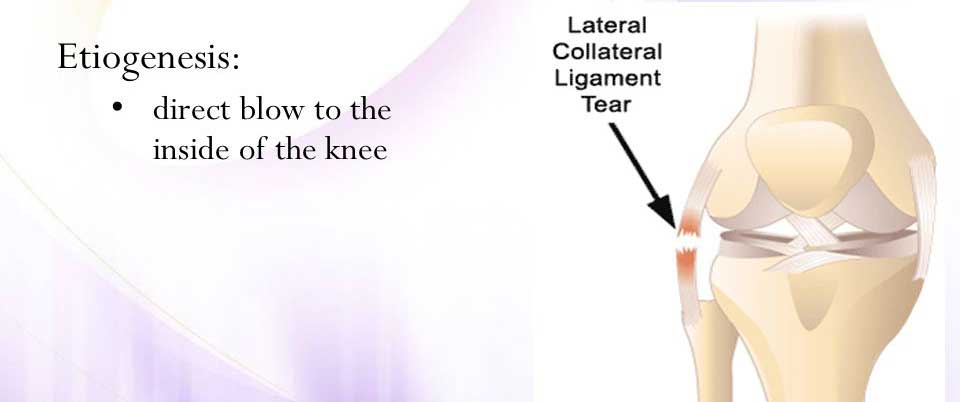
The Lateral Collateral Ligament (LCL) is one of the four main ligaments that help stabilize the knee joint during foot movements and activities. The LCL connects the thighbone to the shinbone on the outer side of the knee, providing stability to that part of the joint and preventing it from opening up or becoming loose. An LCL sprain can range from a mild, partial tear to a complete tear of the ligament. The LCL is one of two ligaments, along with the Medial Collateral Ligament, that are located on the sides of the knee.
The Lateral Collateral Ligament, located on the outer side of the knee joint, can be injured by a direct blow or pressure to the inside of the knee, or by sudden changes in direction that cause the leg to become fixed in an awkward position, putting stress on the ligament. Sports activities such as cricket or football are common causes of LCL tears. However, if you are an athlete with a torn or injured LCL, there is still hope for recovery. The healing process can take anywhere from five to nine months.
The symptoms of a Lateral Collateral Ligament injury are similar to other ligament sprains. You may experience pain and stiffness on the outer side of your knee, along with swelling. Some patients also report a feeling of instability or a popping sensation when walking. Your knee may also feel rigid or locked in place. To confirm the diagnosis of an LCL injury, it's important to consult with your orthopedic surgeon. They can assess the range of motion in your knee and perform various tests to determine the extent of the damage.
 Knee gives away when walking and standing or under stress.
Knee gives away when walking and standing or under stress.
 Have Locking feeling when the knee is in movement
Have Locking feeling when the knee is in movement
 Dullness or tendency in the knee or foot
Dullness or tendency in the knee or foot
 Having Knee swelling, Stiffness, lack motion
Having Knee swelling, Stiffness, lack motion
The hardness of an LCL tear will most often categorize into three grades by the surgeons.
Grade 1- Having minor pain and hardness in the knee for 1-2 weeks
Grade 2 -In 2nd-grade Patients feel having major pain in the knee. It is sensible to looseness and gives outside when you are walking or doing any activity. In this grade not completely torn.
Grade 3- In 3rd grade, your LCL has completely torn and you need to surgery.
If you have sustained a Lateral Collateral Ligament injury, it is important to start with immediate care, which involves the RICE method (Rest, Ice, Compression, and Elevation) to reduce pain and swelling. Anti-inflammatory medications such as painkillers, ibuprofen, and aspirin can also be used to alleviate swelling and pain.
It is crucial to seek proper treatment soon after the injury to ensure a proper recovery if you have a damaged or torn LCL. Failure to do so can result in weakness in the joint, making it susceptible to re-injury.
In Lateral Collateral Ligament surgery, the torn ligament is reattached to the bone using long stitches or a metal staple at the point where it connects to the femur and tibia. This will help restore stability to the knee joint and allow for proper healing.
 After LCL surgery, the knee is maintained by Splinting or brace for 2-3 months.
After LCL surgery, the knee is maintained by Splinting or brace for 2-3 months.
 Improvement is started after an operation to recover movement of the knee and power.
Improvement is started after an operation to recover movement of the knee and power.
 Use daily RICE activity for two to three months
Use daily RICE activity for two to three months
 The knee will have a limitation while in the movement.
The knee will have a limitation while in the movement.
In conclusion, For more information contact to best knee arthroscopic surgeon.
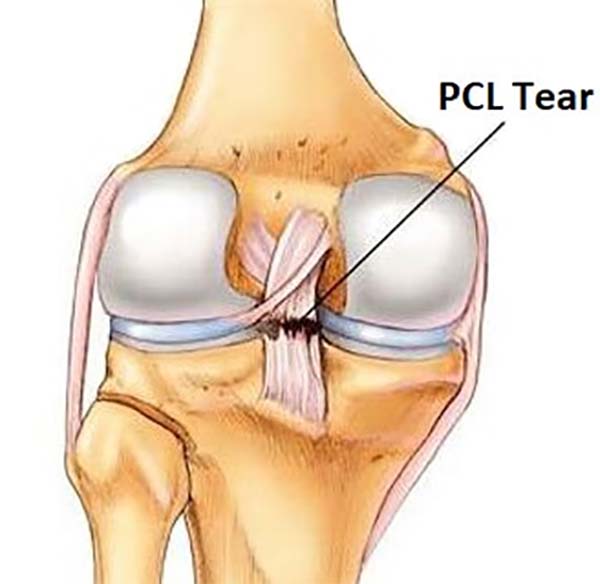
The PCL (posterior cruciate ligament) is one of the most robust ligaments in the knee joint and is less commonly injured, accounting for about 5-35% of all knee injuries. It is located towards the middle and back of the knee structure and connects the thighbone to the shinbone.
During a PCL reconstruction procedure, the damaged or torn ligament is replaced with a graft. Typically, hamstring tissue is used for this grafting process. However, if the PCL is severely damaged, multiple grafting procedures may be necessary.
To ensure a strong fixation of the grafting material inside the knee, most methods use specially designed screws that are inserted into bone tunnels drilled into the knee. This surgical procedure is usually performed on an outpatient basis.
 Restrict the backward migration of the knee.
Restrict the backward migration of the knee.
 Turning behind on itself, Restrict forceful expansion of the knee joint,
Turning behind on itself, Restrict forceful expansion of the knee joint,
 Supports and stable the knee on spin moves and work as a primary axis of the orbit of knee
Supports and stable the knee on spin moves and work as a primary axis of the orbit of knee
 Having Slow movement of the knee.
Having Slow movement of the knee.
 Due to pain while up-down the stairs.
Due to pain while up-down the stairs.
 Having problems, in turn, and twist the knee.
Having problems, in turn, and twist the knee.
 Due to Feeling internal knee pain.
Due to Feeling internal knee pain.
 Having swelling and instability in the knee.
Having swelling and instability in the knee.
The PCL can tear :
 Your knee ligament tibia is bumped hard just under the knee.
Your knee ligament tibia is bumped hard just under the knee.
 When you slip and fall on a twisted knee.
When you slip and fall on a twisted knee.
The treatment approach for a damaged part depends on the severity and location of the injury. In many cases, surgery is not necessary and the injury can be treated with non-surgical methods.
A physical therapist can provide guidance on exercises to help strengthen your knee and improve its balance and stability. Depending on the extent of your injury, your doctor may also prescribe a knee brace or crutches to assist with your recovery.
If the PCL is severely damaged and causing significant pain, an orthopedic surgeon may recommend PCL reconstruction surgery. Since the PCL cannot heal on its own, it must be replaced with alternative tissue.
During PCL reconstruction, the patient is typically placed under general anesthesia to ensure the tissues surrounding the joint are sufficiently relaxed. Four incisions, each around 5mm-20mm in length, are made around the knee to insert a camera and surgical tools into the joint, harvest the graft, and pass it into the knee. Local anesthesia is injected around the knee at the end of the surgery to help manage pain. The entire PCL reconstruction procedure usually takes between 45 minutes and 2 hours.
After the procedure, a rehabilitation program is typically recommended to help the patient regain strength and mobility in the knee. Physical therapy may include exercises to improve balance, stability, and range of motion. Braces or crutches may also be prescribed to assist in the recovery process.
 Especially After the surgery patients have to start operated knee flexion at 0-90° on day one.
Especially After the surgery patients have to start operated knee flexion at 0-90° on day one.
 Use crutches and braces on an affected knee for first 4-6 months.
Use crutches and braces on an affected knee for first 4-6 months.
 Do RICE activity daily: Rest, Ice, compression and elevation, it helps to reduce swelling and pain.
Do RICE activity daily: Rest, Ice, compression and elevation, it helps to reduce swelling and pain.
 Take regularly prescribed medicine by your doctor.
Take regularly prescribed medicine by your doctor.
 Protect the operated knee.
Protect the operated knee.
 Don’t drive any vehicle until your doctor not recommend to drive.
Don’t drive any vehicle until your doctor not recommend to drive.
 Do daily exercise prescribed by your surgeon.
Do daily exercise prescribed by your surgeon.
In conclusion, If you are having any question about the PCL reconstruction please contact knee arthroscopy surgeon-Dr. Suhit Shah.
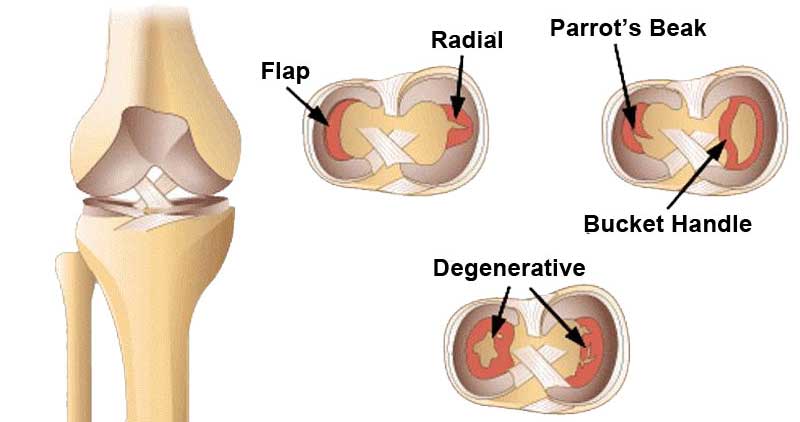
A meniscus tear is a common and painful knee injury that can affect athletes and non-athletes alike. The meniscus is a piece of cartilage located between the thigh bone (femur) and shinbone (tibia) that acts as a cushion and support for the knee joint. Each knee joint has two menisci. The meniscus protects the knee bones from wear and tear, but it can be easily torn with a sudden twisting or rotation of the knee joint, or with activities that put weight, force, or pressure on the knee joint. For example, a football player may tear their meniscus while playing on the field and taking a hard tackle or sudden pivot.
 Football
Football
 Basketball
Basketball
 Volleyball
Volleyball
 Tennis
Tennis
So, Meniscus tears are unusual in older athletes or person. More than 40% of people have this problem in older age.
You can feel a click or pop sound in the knee. Maximum people can walk and do the movement in the injured knee. Many athletes keep playing with a Meniscus tear. Over 2 to 4 days, the affected knee will constantly grow more hardness and swelling.
Then, you may feel
 Having pain in knee especially when you touch that area
Having pain in knee especially when you touch that area
 Due to swelling and redness in an affected area
Due to swelling and redness in an affected area
 Having difficulty in moving the knee
Having difficulty in moving the knee
 Lack of motion area of the knee.
Lack of motion area of the knee.
 Knee locking.
Knee locking.
 Having difficulty in bending your knee
Having difficulty in bending your knee
 Sensing your affected knee “goes out”.
Sensing your affected knee “goes out”.
Knee surgery is a common procedure, especially for meniscus tears. The surgical process involves using a tiny camera inserted through a small incision to view the inside of the knee. The orthopedic surgeon then uses small surgical instruments inserted through other incisions to remove or repair the tear. This minimally invasive approach typically results in less pain, smaller scars, and a quicker recovery time compared to traditional open surgery.
 Partial Meniscectomy method- In this method, the affected meniscus muscle is scraped away.
Partial Meniscectomy method- In this method, the affected meniscus muscle is scraped away.
 Meniscus repair method- Sometimes the damage meniscus tears can be fixed by stitching the split parts mutually. Whether a tear can be successfully performed with replacement depends on the type of infection, as well as the overall the injured meniscus. The meniscus need heal back mutually, the recovery time for a healing take much time than from a meniscectomy.
Meniscus repair method- Sometimes the damage meniscus tears can be fixed by stitching the split parts mutually. Whether a tear can be successfully performed with replacement depends on the type of infection, as well as the overall the injured meniscus. The meniscus need heal back mutually, the recovery time for a healing take much time than from a meniscectomy.
After a successful meniscus surgery and complete healing, your doctor will guide you through rehabilitation exercises to help restore knee function and strength. These exercises may include range-of-motion exercises to increase flexibility and strengthen the knee muscles. Strengthening exercises can help restore the knee's stability and reduce the risk of future injuries. It's important to follow your doctor's instructions for rehabilitation and to avoid high-impact activities until your knee is fully healed.
 Use crutches or braces
Use crutches or braces
 Use ice on an operated knee to reduce swelling
Use ice on an operated knee to reduce swelling
 Compress your knee with an elastic bandage to controlling swelling
Compress your knee with an elastic bandage to controlling swelling
 Elevate your affected knee with a pillow to increase healing tissues
Elevate your affected knee with a pillow to increase healing tissues
 Take the medicine regularly.
Take the medicine regularly.
 Use stretching exercise to help reduce stress to your knee
Use stretching exercise to help reduce stress to your knee
 Especially Avoid jumping and running for start 3 to 4 months after surgery
Especially Avoid jumping and running for start 3 to 4 months after surgery
After surgery, the long-term outlook is positive as the knee can regain its previous range of motion and strength with proper treatment and rehabilitation. However, the success of non-surgical treatment for a meniscus tear depends on the extent of the damage. It is important to consult with a reputable knee specialist if you experience any pain or discomfort.